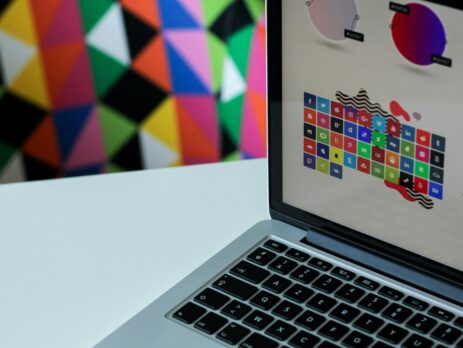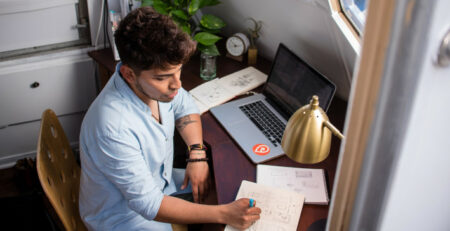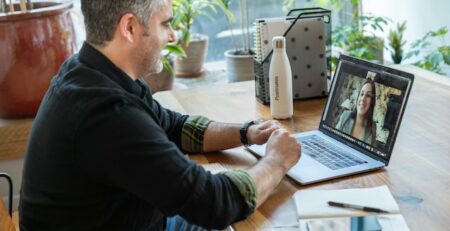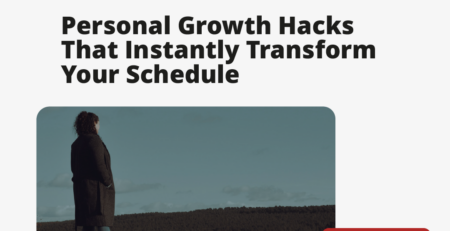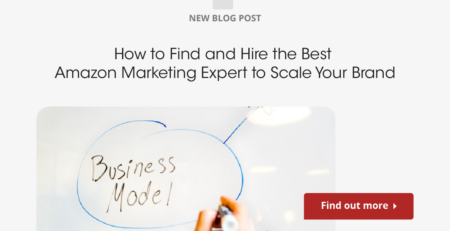Unlock Your Creative Potential: Hiring Tips for UX Designers
In today’s rapidly evolving digital landscape, the role of a UX designer has become increasingly crucial. Companies across various industries seek to enhance user satisfaction by improving the usability, accessibility, and pleasure provided in the interaction between the user and the product. This guide aims to provide comprehensive insights into hiring UX designers, ensuring that you unlock the full creative potential of your team.
Understanding the core competencies of a UX designer is the first step in making informed hiring decisions. A proficient UX designer not only excels in design aesthetics but also possesses a deep understanding of user behavior and psychology. They should be adept at using design tools and have experience in creating intuitive, user-centered designs that align with business goals.
The hiring process for a UX designer should be meticulous and structured. It involves assessing not only the technical skills but also the candidate’s ability to collaborate across different teams and adapt to changing project requirements. Effective communication, a keen eye for detail, and critical thinking are essential traits that contribute to the success of a UX designer within a team.
To attract top talent, companies must also consider the evolving expectations of UX designers. Opportunities for career growth, continuous learning, and a culture that values creativity and innovation are key factors that prospective candidates evaluate. Crafting a compelling job description, showcasing the company’s commitment to UX and providing a clear path for professional development can significantly enhance the attractiveness of the position.
Interviewing candidates for a UX position requires a tailored approach. It’s beneficial to include practical assessments that reflect real-world challenges. These can help gauge the candidate’s problem-solving abilities and their approach to user-centric design. Additionally, discussing past projects and understanding their role in those projects can provide deeper insights into their expertise and working style.
Onboarding new UX designers is just as crucial as the hiring process. A structured onboarding plan helps integrate new hires into the company culture and aligns them with team goals. Regular feedback and mentorship are vital to foster their growth and ensure they contribute effectively to projects.
Retaining skilled UX designers is critical for maintaining the competitive edge of your design team. Regular performance reviews, competitive salary packages, and recognition of good work can help in retaining top talent. Encouraging creativity and providing resources for upskilling can also enhance job satisfaction and loyalty.
As technology evolves, so does the field of UX design. Staying updated with the latest design trends, tools, and methodologies is essential. Encouraging participation in workshops, webinars, and conferences can help your team stay ahead in the game and deliver innovative design solutions that meet user expectations.
Finally, fostering a collaborative environment where feedback is openly shared and creativity is encouraged can lead to more innovative and effective design solutions. Building a team that values diverse perspectives and collaborative problem-solving can significantly enhance the creative output and success of UX projects.
In conclusion, hiring the right UX designer involves a combination of understanding the necessary skills, creating an attractive work environment, and maintaining an ongoing commitment to professional development. By focusing on these areas, companies can unlock the creative potential of their UX teams and drive significant advancements in their projects.
Most Asked Questions About Hiring UX Designers
- What are the essential skills to look for when hiring a UX designer?
- How can I effectively assess a UX designer’s portfolio during the hiring process?
- What are the best interview practices for evaluating UX designers?
- How do I create a compelling UX designer job description to attract top talent?
- What strategies can be employed to retain talented UX designers in a competitive market?
- How important is cultural fit when hiring a UX designer, and how can it be assessed?
- What are the latest trends in UX design that hiring managers should be aware of?
Essential Skills to Look for When Hiring a UX Designer
When hiring a UX designer, it’s crucial to look for a blend of technical and soft skills that will ensure they can effectively contribute to your projects. Technical skills like proficiency in design tools such as Sketch, Adobe XD, and Figma are fundamental. However, understanding of user research methodologies, wireframing, prototyping, and user testing are equally important.
Soft skills play a critical role in a UX designer’s success. Strong communication skills enable designers to articulate their design choices and collaborate effectively with cross-functional teams. Problem-solving skills and empathy are essential for creating designs that meet user needs and enhance user satisfaction.
Creativity and an eye for detail are also important. A designer’s ability to think outside the box can lead to innovative solutions that set products apart in the marketplace. Attention to detail ensures that the final product is not only functional but also free from usability issues.
Experience is another crucial factor to consider. A designer with a robust portfolio that includes a variety of work across different platforms offers insights into their versatility and expertise. It’s beneficial to look for projects in the portfolio that are similar to your company’s projects.
During the hiring process, consider how a candidate has evolved professionally, which can be indicative of their passion and commitment to the UX field. Continuous learning and adaptation are necessary traits in the ever-evolving tech landscape.
Leadership potential is another desirable quality, especially if you are looking to fill a senior UX designer role. The ability to mentor junior designers and lead projects is invaluable as your team grows.
Cultural fit is also significant. A designer who aligns with your company’s values and work environment is more likely to contribute positively and stay with your company longer. This alignment enhances team cohesion and overall productivity.
Finally, a practical assessment during the interview process can help gauge a candidate’s real-world skills. Assigning a small project related to your business can provide insight into their problem-solving approach and how they handle feedback.
By focusing on these skills and qualities, you can ensure that you hire a UX designer who will not only fit in with your team but also drive innovation and user satisfaction in your projects.
Effective Assessment of a UX Designer’s Portfolio
Assessing a UX designer’s portfolio is a critical step in the hiring process. The portfolio not only showcases the candidate’s design skills but also provides insight into their problem-solving capabilities and user-centered design approach. Here are key aspects to consider when reviewing a UX designer’s portfolio.
Firstly, look for a clear demonstration of the design process. A good UX portfolio should outline the problems faced, the processes used to address these problems, and the outcomes. This includes research, wireframes, user flows, and the final designs. Such detailed case studies demonstrate the candidate’s strategic approach to design.
Secondly, evaluate the diversity of projects in the portfolio. A variety of work shows the designer’s ability to adapt to different industries and user types, which is crucial for a dynamic work environment. It also highlights the designer’s versatility in handling various design tools and methodologies.
Usability and functionality of the designs presented should be a focal point. Look for designs that are not only visually appealing but also user-friendly. A good UX designer prioritizes the user experience in every aspect of their design.
Attention to detail is another critical factor. Well-polished and thought-out designs suggest a high level of professionalism and dedication to quality. This trait is essential in a designer as small details can make or break the user experience.
The ability to articulate design decisions is also important. Many portfolios now include explanations or annotations that describe why certain design choices were made. This ability to communicate design thinking shows depth of understanding and the ability to align design with user needs and business goals.
Look for evidence of collaboration in the portfolio. UX design is rarely a solo effort; it involves working closely with developers, product managers, and other stakeholders. Projects that mention teamwork and collaboration indicate a candidate’s ability to work effectively in a team environment.
Feedback and iteration are also part of a robust design process. Portfolios that show revisions and updates based on user feedback demonstrate a commitment to user-centered design and continuous improvement.
Technical skills should be evident in the tools and technologies used. Familiarity with industry-standard UX/UI design tools and technologies is necessary to create effective designs and collaborate with other team members who use these tools.
Finally, consider the overall presentation of the portfolio. A well-organized and easy-to-navigate portfolio reflects the designer’s professionalism and understanding of user experience principles, even in presenting their own work.
By thoroughly assessing a UX designer’s portfolio with these criteria, you can gain a comprehensive understanding of their capabilities and potential fit for your team.

Best Interview Practices for Evaluating UX Designers
Interviewing UX designers requires a strategic approach to accurately assess their skills, thought processes, and suitability for your team. Here are some best practices to follow during the interview process.
Start with a thorough review of the candidate’s portfolio prior to the interview. This allows you to prepare specific questions about their projects and design choices. During the interview, ask them to walk you through their portfolio, focusing on their problem-solving methods and the design decisions they made.
Incorporate practical exercises or design challenges relevant to your company’s projects. These can be done as part of the interview or as a take-home assignment. Such exercises help you evaluate the candidate’s creative process, problem-solving skills, and ability to work under time constraints.
Ask behavioral questions to understand how the candidate has handled past situations related to teamwork, deadlines, and design challenges. Questions like “Can you describe a challenging project and how you handled it?” provide insights into their professional behavior and resilience.
Discuss the candidate’s experience with user research and testing. Understanding their approach to gathering and incorporating user feedback is crucial for assessing their commitment to user-centered design principles.
Explore their technical skills and familiarity with design tools and technologies. This is particularly important if your team uses specific software that the candidate will need to operate effectively.
Assess their communication skills by paying attention to how clearly they articulate their ideas and respond to questions. Effective communication is essential for collaboration within a team and for presenting design concepts to stakeholders.
Consider their cultural fit with your team. Discussing aspects of your company culture and values can help both you and the candidate determine if there is a mutual fit.
Ask about their career aspirations and professional development interests. This can help you understand their long-term potential and alignment with your company’s growth opportunities.
Include other team members in the interview process, especially those who will work directly with the UX designer. This can provide different perspectives on the candidate’s fit and can help assess how well they might integrate with the team.
Finally, provide a clear timeline and next steps at the end of the interview. Transparency in the hiring process reflects well on your company and helps maintain the interest of high-quality candidates.
By following these practices, you can conduct thorough and effective interviews that will help you select the best UX designer for your team.
Creating a Compelling UX Designer Job Description
Crafting a compelling job description for a UX designer is crucial in attracting the right candidates. The job description should clearly outline the responsibilities, required skills, and the benefits of working at your company. Here’s how to create an effective UX designer job description.
Start with a brief overview of your company, including its mission, culture, and any notable achievements or projects. This helps candidates understand the kind of work they would be involved in and the values they are expected to align with.
Clearly list the responsibilities of the UX designer. Be specific about what their day-to-day tasks will include, such as conducting user research, creating wireframes and prototypes, and collaborating with other teams. This helps candidates assess whether their skills and interests match the job requirements.
Detail the necessary qualifications and skills. Include both technical skills, like proficiency in specific design software, and soft skills, such as communication and problem-solving abilities. Also, mention any preferred qualifications that could make a candidate more suitable for the role.
Highlight the opportunities for professional development and career growth within your company. Talented UX designers are often looking for roles that will allow them to grow professionally and have a meaningful impact.
Discuss the benefits and perks offered by your company, such as flexible working hours, remote work options, health insurance, and opportunities for training and development. These are often key considerations for candidates.
Include information about the team they will be joining. Describe the team’s role within the company and how the UX designer will fit into this structure. This helps candidates understand the dynamics and expectations of the team they might join.
Use inclusive language to ensure the job description appeals to a diverse range of candidates. Avoid jargon that might be exclusionary or phrases that could deter qualified candidates from different backgrounds.
Encourage candidates to apply by ending the job description with a call to action. Provide clear instructions on how to apply and what materials (like a portfolio) they should include with their application.
Finally, make sure the job description is well-organized and easy to read. Use bullet points for responsibilities and qualifications to make the information easily digestible.
By following these guidelines, you can create a job description that not only captures the essence of the role and your company but also attracts the most qualified and enthusiastic UX designers.
Strategies to Retain Talented UX Designers
Retaining talented UX designers is crucial for maintaining the stability and creativity of your design team. Here are effective strategies to ensure your top UX talent remains motivated and engaged.
Offer competitive compensation packages that reflect the value UX designers bring to your company. Regularly review salaries to ensure they remain competitive with the market. For more insights, refer to How to Know if Your Salary is Competitive.
Provide opportunities for professional development. This could include sponsoring attendance at industry conferences, providing access to training workshops, and encouraging certification in new UX methodologies. Continuous learning is highly valued by UX professionals.
Encourage a culture of feedback and recognition. Regularly acknowledge the achievements of your UX designers through formal and informal channels. For ideas on recognition, see 10 Ways to Recognize Employees.
Offer challenging projects that allow UX designers to push their boundaries and innovate. This not only leads to job satisfaction but also to personal and professional growth.
Support a work-life balance by offering flexible working hours and the option for remote work. For tips on managing remote teams, visit Tips for Managing a Remote Work Force and How to Become an Effective Remote Manager.
Involve UX designers in strategic decisions, especially those that affect the product development process. This inclusion not only makes them feel valued but also ensures that designs are user-centric.
Encourage a collaborative team environment where creativity and innovation can thrive. This includes regular brainstorming sessions and workshops that foster creative thinking.
Implement a clear career path for UX professionals in your organization. This should include potential career progression, expected milestones, and the support they will receive to move up within the company.
Focus on building a positive company culture that aligns with the values of your UX team. This can include team-building activities, community involvement initiatives, and a supportive work environment.
By implementing these strategies, staffing creative agencies like icreatives staffing can create a work environment that not only attracts but also retains top UX design talent, thereby ensuring the long-term success of your design initiatives.
Importance of Cultural Fit in Hiring UX Designers
When hiring UX designers, assessing cultural fit is just as important as evaluating technical skills. A designer who meshes well with your company culture is more likely to be productive, collaborate effectively with other team members, and stay with your company longer.
To assess cultural fit, consider the core values and behaviors that are important to your organization. During the interview, ask questions that reveal how the candidate’s values align with those of your company. For example, if teamwork is a core value, ask about their experiences working in team environments.
Observe the candidate’s interaction style during the interview. Are they open and communicative? Do they show enthusiasm for collaboration? Their demeanor can provide clues about how well they will integrate with your team.
Discuss the company’s mission and goals during the interview. This helps candidates understand the bigger picture and assess whether it aligns with their professional aspirations and values.
Consider involving various team members in the hiring process. This can provide different perspectives on the candidate’s fit and how they might interact with potential colleagues.
Look for flexibility and adaptability in candidates. A designer who is open to feedback and can adapt to new situations is more likely to thrive in environments that are dynamic and evolving.
Assess their problem-solving and conflict-resolution skills. These are important in maintaining a harmonious work environment, especially when creative disagreements arise.
Pay attention to the questions candidates ask during the interview. Questions about team dynamics, company culture, and values indicate their interest in finding a good cultural fit.
After the interview, consider a trial project or a day spent with the team. This can be an effective way to see how the candidate interacts with team members and handles real work scenarios
.
Finally, after the hiring process, solicit feedback from both the candidate and the team. This feedback can provide valuable insights into the effectiveness of your cultural assessment process and help refine future hiring strategies.
By prioritizing cultural fit alongside technical skills, you can ensure that new hires will not only contribute to your projects but also enhance the team dynamics and overall workplace environment.
Latest Trends in UX Design for Hiring Managers
Staying informed about the latest trends in UX design is crucial for hiring managers looking to recruit top talent and innovate within their projects. Here are some of the key trends currently shaping the UX design landscape.
One significant trend is the increasing importance of accessibility in design. UX designers are now expected to create products that are accessible to all users, including those with disabilities. This requires a deep understanding of accessibility standards and guidelines.
Another trend is the integration of AI and machine learning into the design process. These technologies are being used to automate routine tasks, analyze user behavior, and personalize user experiences. UX designers need to be familiar with these technologies to create designs that leverage their capabilities.
The rise of voice user interfaces (VUIs) and conversational design is also notable. As more devices and applications incorporate voice interaction, UX designers must understand how to design for voice in addition to traditional screen-based interfaces.
There is also a growing focus on ethical design practices. With increasing concerns about privacy and data security, UX designers are now expected to consider the ethical implications of their designs and strive for transparency and user trust.
Remote collaboration tools have become essential, especially in the context of the global pandemic. UX designers must be adept at using these tools to collaborate effectively with remote teams and stakeholders.
Microinteractions are small, functional animations that enhance the user experience. These subtle design elements can significantly impact user engagement and satisfaction, making them a critical focus for UX designers.
The concept of digital well-being is gaining traction. UX designers are challenged to create designs that promote healthy usage patterns and contribute to the overall well-being of users.
Finally, the need for continuous learning and adaptation is more pronounced than ever. UX designers must stay updated with the latest design tools, trends, and methodologies to remain competitive and effective in their roles.
By understanding these trends, hiring managers can better assess the skills and knowledge of UX designer candidates, ensuring that their teams are equipped to tackle current and future challenges in the design landscape.
Conclusion
In conclusion, hiring the right UX designer is a multifaceted process that requires a deep understanding of both the technical skills and the softer, interpersonal qualities that lead to successful design outcomes. From crafting a compelling job description to conducting thorough interviews and ensuring a good cultural fit, each step is crucial in finding a designer who will not only enhance the user experience but also fit seamlessly into your team.
Moreover, retaining talent through competitive compensation, opportunities for growth, and a supportive work environment is essential for maintaining a stable and innovative design team. Staying abreast of the latest trends in UX design will also equip hiring managers with the knowledge to make informed decisions that align with industry standards and user expectations.
Ultimately, the goal is to create a team that is not only skilled and efficient but also committed and creatively fulfilled. By focusing on these elements, companies can ensure their UX design teams are well-positioned to contribute to the company’s success in an increasingly digital world.
For further insights into managing and enhancing your team’s productivity, consider exploring additional resources such as The Ultimate Guide to Boost Your Productivity with AI Tools at Work.
In today’s competitive market, finding the right creative and marketing expert can be a challenge. But with icreatives, you’re in experienced hands. With 37 years in staffing and a track record of matching more than 10,000 employees to over 1,000 companies worldwide, we know how to connect you with the best. Plus, you only pay if you hire—there’s no risk, only results.
Ready to find your perfect creative or marketing expert? HIRE WITH ICREATIVES today!

